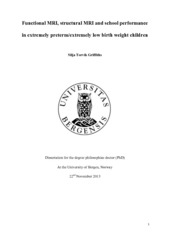| dc.contributor.author | Griffiths, Silja Torvik | en_US |
| dc.date.accessioned | 2014-09-01T11:12:31Z | |
| dc.date.available | 2014-09-01T11:12:31Z | |
| dc.date.issued | 2013-11-22 | eng |
| dc.identifier.isbn | 978-82-308-2415-3 | en_US |
| dc.identifier.uri | https://hdl.handle.net/1956/8395 | |
| dc.description.abstract | Purpose: Numbers of extremely preterm (EPT) children who survive is steadily increasing, and the majority of these children are in need of help at school. The purpose of this regional, clinical controlled cohort study was to compare anatomy and function of the brain in EPT/extremely low birth weight (ELBW) and term born children at eleven years of age, and study the relation to school performance and cognitive skills. Brain anatomy findings were also compared to young adults born very preterm. Method: A population based cohort of all EPT/ELBW (gestational age (GA) < 28 weeks or birth weight (BW) < 1000g) children born in Hordaland or Sogn- og Fjordane in 1999-2000, was the basis for this thesis. An additional cohort of very preterm (VPT, GA 28-31) young adults (19 years) was included. Both cohorts were compared to a randomly selected, age appropriate term born control group. In paper I, frequency and magnitude of cerebral brain pathology assessed by magnetic resonance imaging (MRI) in EPT, VPT and term born children/young adults were investigated. In paper II, a possible difference in blood oxygen level dependent (BOLD) activation, assessed by functional magnetic resonance imaging (fMRI) and performance during a working memory/selective attention task (the n-back/Stroop task), between EPT/ELBW and term born children was analysed. In paper III, a possible association between school performance, assessed by compulsory national school tests, scores on a working memory/selective attention task, BOLD activation during this task and prematurity was investigated. Results: Paper I: An increased frequency of MRI pathology was found in both the EPT and the VPT cohorts compared to their respective term born control groups. The frequency was higher in the EPT than the VPT group, but also higher in the EPT controls than the VPT controls. Group differences were mainly limited to mild pathology. Paper II: When performing a working memory/selective attention task, the eleven year old regional EPT/ELBW cohort showed the same pattern of brain activation as the term born control group, but the intensity was significantly reduced. The main areas of activation were the prefrontal and parietal areas and the anterior cingulate cortex (ACC). The EPT/ELBW children had fewer correct responses, particularly in the cognitively more demanding settings. Paper III: There was no significant difference in school performance between the children born EPT/ELBW and at term. There was a significant positive association between correct responses on the n-back/Stroop task and school performance, independent of prematurity (r=0.41, p=0.004). BOLD activation was associated with response accuracy on the n-back/Stroop task, but not with school performance. The BOLD activation pattern in children scoring high versus low on the n-back/Stroop task was different compared to the pattern in preterm versus term born control children. Conclusions: The same structural MRI pathology was found in subjects born EPT, VPT and at term, but less frequently in those born at term. MRI lesions were more common in the EPT than the VPT group, but also in the EPT control group compared to the VPT control group. Lack of objective criteria for differentiating mild pathology from normality at the different ages may be the cause of differences in the term born groups. The fMRI study demonstrated that working memory and selective attention capacity was reduced in EPT/ELBW children compared to term born controls, with a matching reduction in BOLD activation in areas responsible for cognitive control. High BOLD brain activation was associated with better cognitive performance. Although cognitive performance was positively associated with school performance, BOLD activation did not reflect school performance. | en_US |
| dc.language.iso | eng | eng |
| dc.publisher | The University of Bergen | eng |
| dc.relation.haspart | Paper I: Griffiths ST, Elgen IB, Chong WK, Odberg MD, Markestad T, Neto E, Aukland SM. Cerebral Magnetic Resonance Imaging Findings in Children Born Extremely Preterm, Very Preterm, and at Term. Pediatric Neurology 2013 Aug;49(2):113-18. The article is not available in BORA due to publisher restrictions. The published version is available at: <a href="http://dx.doi.org/10.1016/j.pediatrneurol.2013.03.006" target="blank">http://dx.doi.org/10.1016/j.pediatrneurol.2013.03.006</a> | en_US |
| dc.relation.haspart | Paper II: Griffiths, ST, Gundersen H, Neto E, Elgen I, Markestad T, Aukland SM, Hugdahl K. fMRI: blood oxygen level-dependent activation during a working memory-selective attention task in children born extremely preterm. Pediatr Res 2013;74(2): 196-205. The article is not available in BORA due to publisher restrictions. The published version is available at: <a href="http://dx.doi.org/10.1038/pr.2013.79" target="blank"> http://dx.doi.org/10.1038/pr.2013.79</a> | en_US |
| dc.relation.haspart | Paper III: Griffiths ST, Aukland SM, Markestad T, Eide GE, Elgen I, Craven AC, Hugdahl K. Functional Magnetic Resonance Imaging, school performance and prematurity: a regional, clinical-controlled cohort study. The article is not available in BORA. | en_US |
| dc.title | Functional MRI, structural MRI and school performance in extremely preterm/extremely low birth weight children | en_US |
| dc.type | Doctoral thesis | |
| dc.rights.holder | Copyright the author. All rights reserved | |
| dc.identifier.cristin | 1067560 | |
